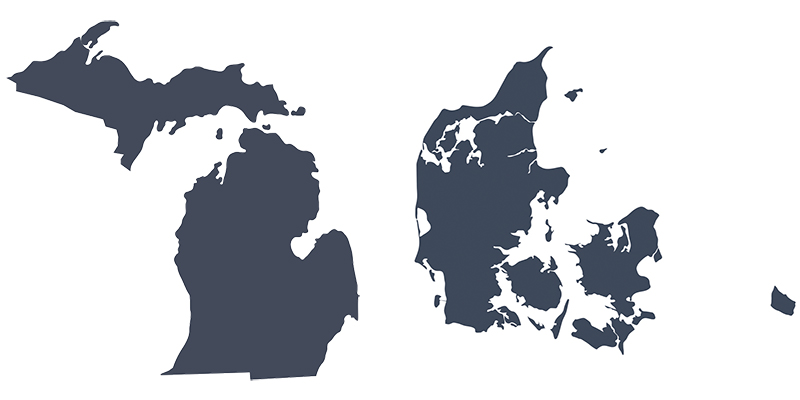
The Kingdom of Denmark is a small Scandinavian country that has one land border — in the south, with Germany — which extends just 42 miles. With a population of 5.8 million people, Denmark covers about the same area as Michigan’s Upper Peninsula, 16,500 square miles, but in shape and geographic orientation, it remarkably resembles the Lower Peninsula.
The part of Denmark that juts up between the North Sea and Baltic Sea is fittingly called Jutland. In the southeast, Zealand is the largest of a cluster of islands. A combination tunnel-and-bridge leads five miles across Øresund Strait, connecting Zealand and the national capital, Copenhagen, to Sweden.
The Kingdom also includes the territories of Greenland and the Faroe Islands in the north Atlantic Ocean. Greenland is 50 times larger than Denmark proper, but Danes laughed in 2019 when President Donald Trump suggested the United States might want to buy the enormous island, which had not been offered for sale. There was precedent for the idea, though. In 1917, the U.S. acquired the Danish West Indies for $25 million and renamed them the Virgin Islands.
Mixing Danish commerce with Michigan encompasses a few surprises. Denmark has no auto industry, but under the umbrella of Harman International, Bang & Olufsen A/S supplies audio components to Ford Motor Co., equipping its global lineup of crossovers and SUVs, including the Edge, Mustang Mach E, and Escape.
A robotics hub in Odense, on the island of Funen, is home to Universal Robots A/S, which has dominated the worldwide market for collaborative robots, or cobots. From its North American headquarters in Ann Arbor, UR overnights parts to any North American location instead of returning the robot to Denmark for service.
Two years ago, Guardian Industries Corp. in Auburn Hills launched a strategic agreement with another major player in the Odense robotics hub, Mobile Industrial Robots A/S. MIR’s autonomous robots carry pallets or other bulky loads through a factory.
Denmark’s strong design tradition has led to significant contributions in the furniture and textile industries, with reciprocity occurring among Danish and Michigan companies. In 2019, Herman Miller Inc. in Zeeland completed a $144 million deal for two-thirds’ stake in the HAY brand from Nine United Denmark A/S. Herman Miller CEO Andi Owen said the move would help the company reach “a younger, more urban demographic that we’ve been targeting for expansion.” Meanwhile, in its marketing, Steelcase Inc. flouts the Danish concept of “hygge,” which loosely means “coziness.” The Grand Rapids company offers a collection from privately owned Carl Hansen & Søn, including pieces by Hans Wegner, the master of Mid-century Modern design.
In textiles, Kvadrat A/S last year opened its North American headquarters in Grand Rapids, as well as showrooms in New York and Los Angeles. From the charming town of Ebeltoft, situated on Jutland’s “nose,” Kvadrat creates textiles in vibrant colors for upholstery that’s used by the architecture-and-design community and large companies.












